The words ‘wet room’ conjure up images of hotel-style power showers, huge, walk-in spaces and sleek good looks. The reality is that they’ve filtered down and have become a viable option for pretty much every home. But what are the realities of this luxurious dream? Are we talking bathroom heaven or wet rot hell? Here, we look at what you need to know before installing a wet room, from pros and cons to practicalities and costs.
What exactly is a wet room and why would I want one?
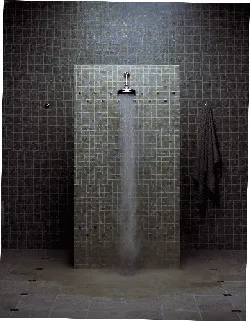
In a conventional wet room, the whole bathroom is, potentially, the shower area. There’s no step up or down into the shower cubicle – in fact, there’s no shower cubicle; instead, the room is tanked (treated to make it completely waterproof) and given a floor drain and a decent-sized shower head. Add a loo and a basin, and bingo! You’ve got a typical wet room.
Wet rooms done well are fashionably modern and minimal, and seen as the last word in luxury. They offer a flexible use of space that’s not constrained by conventional shower-tray shapes and sizes, and some claim that they add value to a property – though it must be said that this is more likely to apply to high-end, urban homes. They are easy to keep clean – no fiddling around the screen or tray, just a mop around as necessary. And finally, thanks to their ease of access, wet rooms can be better for children, older people or anyone with impaired mobility.
What's involved in the installation?
- SIZEA basic wet room can be created in any space that’s large enough to shower in. From there on, the sky’s the limit. Too large, though, and you’re just creating ‘dead’ space that has to be tiled, lit and heated – an expensive option.
- PLACEWet rooms are ideal for ground floors and basements, where the sub-floor is more likely to be solid. On an upper floor you may need to strengthen joists in order to bear the load of heavy stone tiles; you’ll certainly need to ensure that the floor is stable, as wooden joists that flex could create cracks in tiles or waterproofing. The experts at Roman Showers recommend over-boarding with waterproof plywood, at least 12mm thick, screwed to the joists every 200mm.
- DRAINAGEYou must create a gentle slope in the floor so that water will drain away. There are two ways of doing this: either by spreading a levelling compound to form a slope of 1:100 for an ordinary shower (1:200 for a power shower), or by buying a pre-formed tray that you set into the floor. Bear in mind that, to accommodate waste fittings, you may need to raise the entire floor level of the room.
- WATERPROOFINGThis is known as ‘tanking’ and is a vital part of the installation of any wet room. It may be in the form of impermeable sheeting or a trowelled-on sealant, and should be applied to the whole floor of the wet room and to any wallspace that is likely to get wet. Allow an extra 50cm each side to be safe. Another option for walls is to use prefabricated water-resistant boarding.
- WATER SUPPLYIf you have low water pressure or a small tank, you may need to fit a bigger tank or add a pump.
- VENTILATIONFit a really good extractor fan, following building regulations (ask your local planning authority), and avoid condensation by also having some form of heating in the room.
FITTING OUT A WETROOM
A GLASS PARTITION

Not essential but often useful, a fixed glass partition retains an open, airy feel but provides a splash barrier. Straight or curved, it could be placed at right angles to a wall so as to create a shower in a corner, or parallel with a long wall so that you can walk in at either end. The New Wet Room Walk In from Matki has adjustable brace bars, which allows you to alter the size to fit your space. £1,512.25
WALLS

Ceramic, stone and mosaic, again, are all good choices. Glass tiles, either plain or iridescent, offer an attractive option, or it’s possible to buy solid or laminate man-made sheets, usually in marble- or stone-effect. These are easy to maintain and can be effective, but cheaper versions tend to look a little institutional. Glistening Iridescent Glass Mosaic tiles in ‘Sandstone’, £394.44 per sq m from Fired Earth
FIXTURES
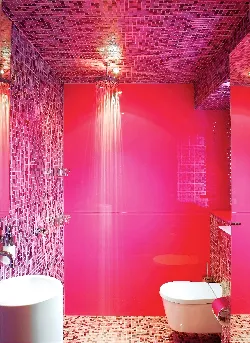
To complement the wet room ‘look’, clean-lined, wall-hung fittings are ideal, though slightly more expensive than conventional types. Box in all pipework behind false walls for an uncluttered effect. This will also allow you to make recessed storage niches – a neater solution than the conventional shower shelf. Make and impact by using wall to floor tiles in the same bright colour. This Ripples design design features 'Marlene' mosaic tiles from Bisazza. Prices from £185.65 per sq m.
LIGHTING
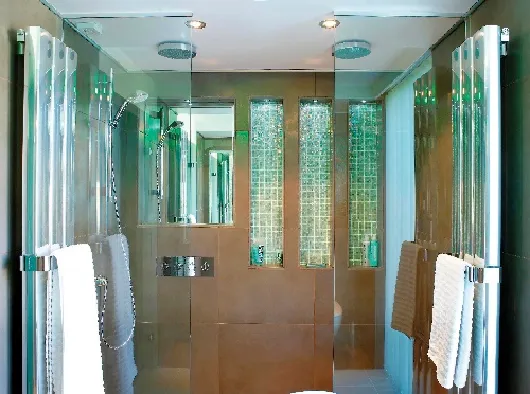
Inset ceiling downlights are unobtrusive yet practical. High-tech options include insetting tiny, glowing LED lights in a glass panel, and chromatherapy showers, featuring a sequence of colour-changing lights. Ripples offers a bespoke shower screen service. Prices start at £959
HEATING

Underfloor heating is ideal, and there are two types: either ‘wet’, with pipes buried in the screed or run under the floor, or ‘dry’, an electric mat or loose wire that sits in the tile adhesive.
CASE STUDY: DARLINGTON
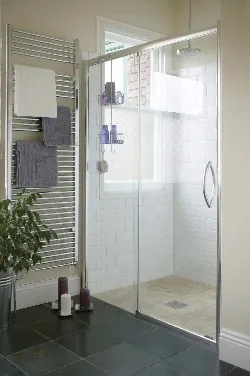
Kathryn Osborne, who lives in a Victorian house in Darlington, installed a wet room last year in what had been an old-fashioned second-floor shower room. Opting for a room with an enclosed shower area – better suited to the colder climate in the north of England – she chose a minimal sliding door (‘Orbital’ from Roman) rather than a more typical fixed glass panel. This keeps steam in and helps block draughts.
The tanking was done with Roman’s ‘Shield’ system: the floorboards were removed, heavy-duty plywood sheets screwed to the joists, and the tanking compound applied on top. Kathryn chose simple white, rectangular tiles for the walls, and stone-effect mosaic for the floor,
with a fixed overhead shower head, also from Roman, that was lengthened slightly so that it hung from the ceiling at the correct height.
The total cost of the wet room, not including labour, was around £2,200, and the project, carried out by local builders, took just two weeks. ‘The whole process was completely pain-free,’ says Kathryn. ‘Our new wet room is more spacious and much more enjoyable to shower in than a small cubicle or over-bath arrangement. It’s completely water-tight and also much easier to clean. Many of our friends and family have commented on it, and it’s a real talking point when we have visitors to stay – several of our friends have even gone on to install wet rooms in their own houses!’
PITFALLS TO AVOID
LEAKS
Every homeowner’s nightmare. Avoid them by ensuring the correct tanking products are meticulously installed – unless you’re really proficient, this isn’t a DIY job.
MOULD
Really good ventilation is the only way to prevent condensation (from warm air meeting cold surfaces) and the resulting mould. Jeff Howell, author of The Sunday Telegraph Guide to Looking After your Property (Macmillan), suggests a combination of constant heating and an extractor fan.
DEVALUING YOUR HOME
Don’t convert your only bathroom into a wet room unless you want to put off potential buyers, who tend to want at least one conventional bath. And adding an inappropriately over-the-top wet room to an otherwise ordinary house is another bad idea.
- The ‘AquaSpace’ wetroom conversion kit from Aqualux consists of adjustable support feet to cater for uneven floors. Prices start at £50 for the kit and from £700 for the wetroom pictured

- Washstand created using Iridescent Glass Mosaic tiles in ‘Incense Fusion’, £429.95 per sq m, and the ‘Mythica’ washbasin, £2,245. Both from Fired Earth
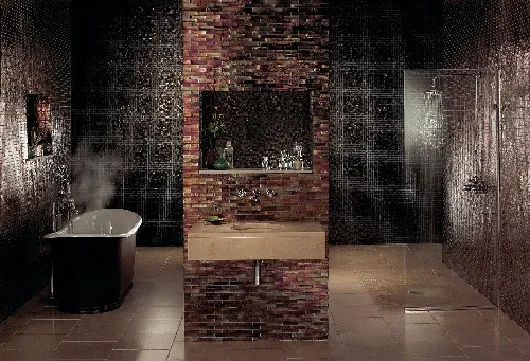
- The ‘Freedom Colossus’ from Roman Showers is made from a single piece of glass and has the option of a tray. Prices start at £868
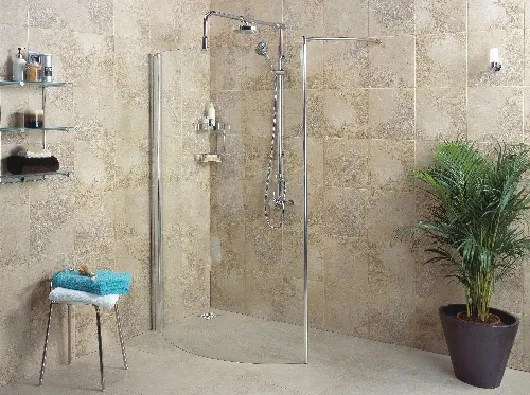
- Matki’s sleek Wetroom Straight Panel costs £2,249.40. This includes the ‘Deluge’ easy-clean showerhead
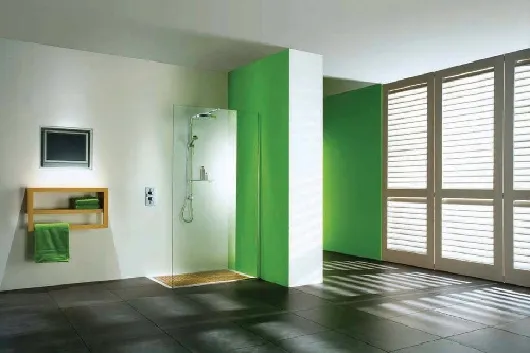
- Circlular shaped wetroom from Ripples, base tiled using ‘Rio Tinta’ mosaic tiles, from £6.20 per sheet
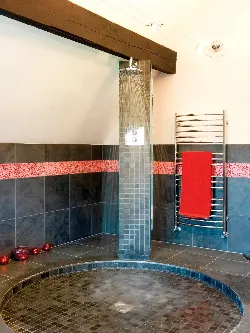
FROM WATERFALLS TO WET ROOMS
Showers have come a long way since we stood under a waterfall to wash off the dirt. The ancient Egyptians appear to have built rudimentary shower rooms in which servants poured water over the bather from a jug; the ancient Greeks used outdoor fountains and had systems involving overhead piped water that ran into a drain. But the shower as we know it was developed in the 18th century. Englishman William Feetham was awarded the first patent for a shower in 1767: cold water had to be hand-pumped and recirculated and, perhaps not surprisingly, it didn’t really catch on. A more basic form of shower involved a tank supported six feet or so above a stand-in basin, filled by a servant on a step-ladder. It took the advent of piped hot water supplies within the home before a steaming hot shower became possible and, in the late 19th century, manufacturers developed some impressive ranges of showers with multiple heads and body sprays. It was but a short step to the spa bathroom and wet room of today.
HOW MUCH WILL IT COST
Roman’s managing director, David Osborne, points out that as wet rooms become more popular, prices are becoming more competitive. ‘This means you can now purchase a wet room panel and tanking system for a similar price to that of a stylish shower enclosure and tray,’ he says. Tanking products may cost less than £300 but, on top of that, you need to account for adhesives and grout, the waste and other plumbing fittings, an extractor fan, and some form of heating. Wall and floor coverings vary hugely in price, so shop around until you find something within your budget. Then add the shower head (from £200 or so) and, if you want one, a glass partition, which could cost from around £250 to £750. As a rough rule of thumb, you can expect to pay about the same again for labour as you do for materials.
H&A’s WETROOM DIRECTORY
0870 241 6131
0845 609 6688
020 7584 8837
0845 600 1950
0845 873 8840
0800 626 717
020 7242 7583
0845 366 0400
01782 524000
01372 472001
0800 590311
01722 415000
01454 322888
0845 257 6951
01392 473000
0870 750 1626
0845 050 4032
020 7384 9090
0844 980 0750